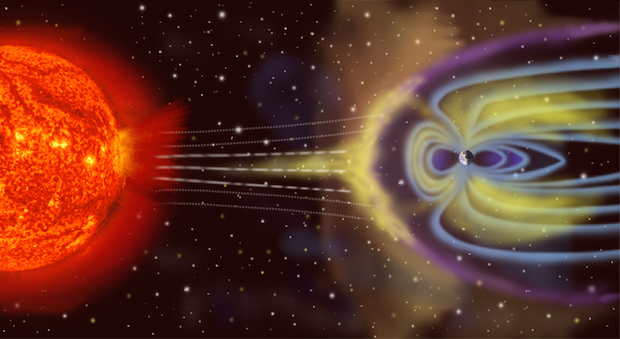National Science Foundation funds effort to see if distant solar systems may support life
Members of the Rice Space Institute’s Laboratory for Space and Astrophysical Plasmas have won a $1 million National Science Foundation (NSF) award to investigate the magnetic interactions between stars and their planets.
The goal of Rice University space scientists and astronomers will be to use well-understood processes in our own solar system to help narrow the search for potentially habitable planets among the 200 billion estimated to exist in the Milky Way galaxy.
The researchers will rely on sophisticated computational models, many developed at Rice, to apply what they’ve learned about sun-Earth interactions to potentially habitable planets elsewhere. They also will calculate the strength of expected radio signals from such magnetically endowed exoplanets — planets that orbit a star other than the sun.

Scientists at Rice University will lead a study of distant solar systems to see if their planets have magnetic fields similar to the one illustrated here, which protects Earth from energetic charged particles emitted by the sun. Courtesy of NASA
“We’re trying to explore how the knowledge we have gained over 50 years of space research focused on our own solar system can lend itself to this new regime,” said David Alexander, a Rice professor of physics and astronomy, director of the Rice Space Institute and principal investigator for the project.
“This is exploratory,” he said. “We don’t know what the answers are going to be. But one thing we are targeting is whether we can determine and ultimately observe signatures of the exoplanets’ magnetic fields.”
Earth’s magnetic field shields it from the sun’s constant stream of energetic charged particles, known as the solar wind. “Earth would not be so hospitable a planet if it weren’t for its magnetic field,” Alexander said. “The field protects us from the sun’s particle radiation, which is composed primarily of fast-moving protons and electrons.”
Interaction between the magnetic fields of stars and planets generates a wide variety of radio emissions from the planets’ magnetospheres. The Rice team plans to calculate the expected emissions from these interactions for a wide range of star-planet systems. “This is nontrivial, as no star is really exactly identical to the sun, nor planet exactly identical to Earth, but we hope that by allowing for the differences in existing simulations, new knowledge can be gained,” he said. “We want to help identify systems where we think the activity level of the star and the expected magnetic field strength of the planet is a combination that would provide a safe harbor for life.”
He said the planetary radio emissions will most likely be too weak to detect with current systems, but the techniques they develop will prepare scientists to monitor emissions from exoplanets with the more sophisticated radio telescopes to come. “I think we’ll learn some new science about our own solar system in the process,” Alexander said.
He noted the project is a natural fit for the nation’s first space science program, founded at Rice in 1963. “We have a huge heritage in understanding how the sun interacts with planets in the solar system. It was part of the very first space physics department to understand how Earth responds to energy from the sun.”
The multiyear grant is part of the NSF’s Integrated NSF Support Promoting Interdisciplinary Research and Education — or INSPIRE — program, which funds proposals for transformative research whose potential advances lie outside the scope of a single program or discipline. The grant includes funds for a summer institute at the Planetary Habitability Lab at the University of Puerto Rico at Arecibo. The lab works closely with the Arecibo Observatory, the world’s largest radio telescope. Former Rice Provost William Gordon founded and supervised the observatory’s construction.
Joining Alexander are co-investigators Christopher Johns-Krull, Anthony Chan and Frank Toffoletto, all professors of physics and astronomy; Stephen Bradshaw, an assistant professor and the William V. Vietti Junior Chair of Space Physics; Stanislav Sazykin, a senior faculty fellow, all at Rice; and Abel Méndez, a professor at the University of Puerto Rico.
Other collaborators are Robert Kerr, director of the Arecibo Observatory; and Tom Hill and Richard Wolf, research professors and professors emeritus of physics and astronomy; Andrea Isella, an assistant professor of physics and astronomy, and Patricia Reiff, a professor of physics and astronomy and associate director of the Rice Space Institute, all at Rice.
“One reason there are so many people involved is because we need everyone’s expertise in a truly multidisciplinary project like this,” Alexander said. “We all have our own scientific interests and projects, but to be able to do work together is icing on the cake.”


Leave a Reply